Adelaide Festival and Adelaide Fringe 2024 reviews: Marrow, Time Machine, There Will Come Soft Rain, Biennial of Australian Art
It’s the final weekend of the Adelaide Festival and Adelaide Fringe – but it’s not too late to catch a show or two. Here’s our verdict on some of the remaining shows in this year’s program.
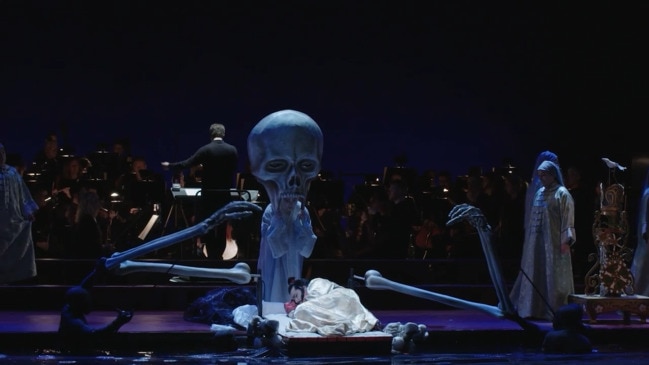
Adelaide Festival
Don't miss out on the headlines from Adelaide Festival. Followed categories will be added to My News.
It’s the final weekend of the Adelaide Festival and Adelaide Fringe – but it’s not too late to catch a show or two.
Here’s our verdict on some of the remaining shows in this year’s program.
Antigone in the Amazon
Dunstan Playhouse
March 15-17
4 stars
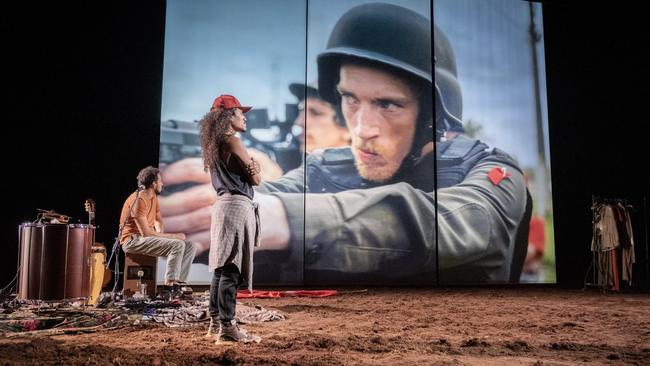
This drama mixes media, documentary, and real events with an ancient anti-fascist sermon from Sophocles in his play Antigone.
It has led a theatre ensemble directed by Milo Rau to film itself performing scenes from Antigone for Amazon forest-dwellers, and organising the recreation of an infamous massacre of farm labourers seeking land rights on former Amazon forest land in Brazil in 1996, known as the Eldorado do Carajás Massacre.
Mixing these disparate forms takes place on a stage simply dressed with a one-man band, actors, tables and chairs and an earthen floor. When required, large screens descend to show the ensemble’s work on the Antigone project in Brazil.
It is the guitarist’s task to tie this informal, messy mixture of elements into some kind of whole, but it remains an event of moments ahead of entirety.
In the original, Antigone is the sister of two brothers killed in battle. When King Creon issues an edict that one will be buried with full honours, the other left to rot, Antigone insists that it is her natural right to bury her brother, despite whatever Creon dictates, and despite the certainty of her own punishment by death.
Today the community of farm workers that survived the Eldorado do Carajás Massacre still remember their 21 lost comrades. The spectacular re-enactment was directed and filmed by Milo Rau, at the site, and before hundreds of onlookers. The violence of the massacre spills directly onto the stage in one of the most effective scenes of the performance, with the onstage ensemble and filmed performers one and the same.
Rau has substituted Greek tragedy’s practice of events taking place offstage for enacting them on film, making a filmed choir/ensemble from Eldorado do Carajás in place of a traditional chorus.
– Tim Lloyd
Mythos: Ragnarok
The Garden of Unearthly Delights
Until March 17
4 stars

If Mythos: Ragnarok is anything to go by, almost any story would be made much better with a sprinkle of professional wrestling. As it happens, the story of the Norse gods, with their endless quibbles and quarrels, is a perfect match.
Mythos Theatre’s stars are all professional wrestlers from the UK. They wear almost no protective clothing, and there is no ring separating stage and audience. They throw, supplex, mat slam and otherwise manhandle each other in a glorious pageant of sweaty athleticism, telling the story of Thor, Loki, and their epic brotherly feud.
There are big hits, and, boy, do they come fast and frequently. When Loki was flung by the arms, rolled off the mat, and nearly crushed my toes, I was hooked. And that was just in the first 10 minutes.
Like WWE, the acting is hokey in the best, cheesiest way imaginable. Like WWE, you can’t help be swept along. I, for one, can’t wait to see what comes next. Other myths? Episodes from history? US presidential politics? The possibilities are endless. See them while you can, and watch out for flying objects.
– George Yankovich
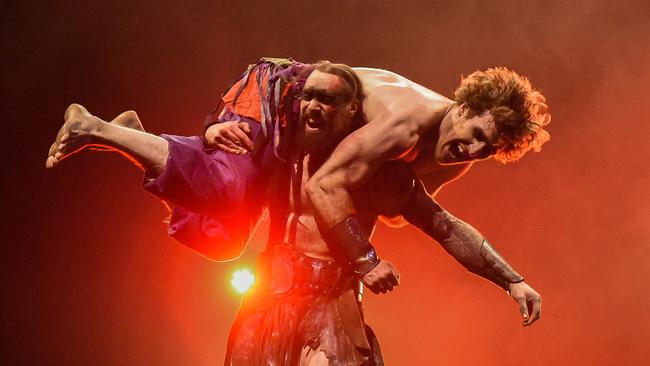
Marrow
Odeon Theatre
March 13 – 17
4 stars


It’s a commonplace that the arts are unique for enabling us to process our lives individually, and to come together collectively. And never more so than in times of crisis.
For the vast majority of First Nations people, the failed Voice referendum was a shattering blow, and in the coming years we will see many responses to it, on stage and screen.
Australian Dance Theatre’s Marrow, premiering at the 2024 Adelaide Festival, is such a piece. ADT Artistic Director Daniel Riley has put together a really skilful work that takes us back to the Dreamtime itself – to the core, the marrow, of the world’s oldest civilisation.
Among Riley’s many collaborators is Kaurna/Ngarrindjerri elder, Uncle Moogy Sumner, who told him the Dreaming story of waatji pulyeri, the blue wren, who sought to make himself better than all the rest, only to be punished everlastingly for his deceit. And sure enough, a wren is their, a tiny speck ofblue to the side of the black stage. Almost hidden, like the punishment meted out to waatji pulyeri.
The movement is at once reminiscent of wrens scurrying about on the ground, stalking and
capturing their insect prey, all driven by a propulsive score from James Howard. A thrilling burst of action from Sebastian Geilings really focuses the mind, and the eye. There’s something building here.
A final character in the piece is incorporeal, a puff of smoke through which the dancers weave, sometimes in close proximity, others simply bursting through. Hard to pin down, and impossible to tame.
For its many fine qualities, Marrow needs a bit of tweaking.
The production feels unfinished, hardly Festival quality, with the set per se comprising a black sheet and a perfunctory stuffed bird. But it remains an engaging new work, taking a few risks along the way.
Waatji pulyeri’s pride led it down a path where the goal became more about others than about self; where the aim was to disprove the doubters, not on fulfilment. We associate ourselves with it, and its condemnation to life in the shadows, out of sight, at our peril.
– Peter Burdon
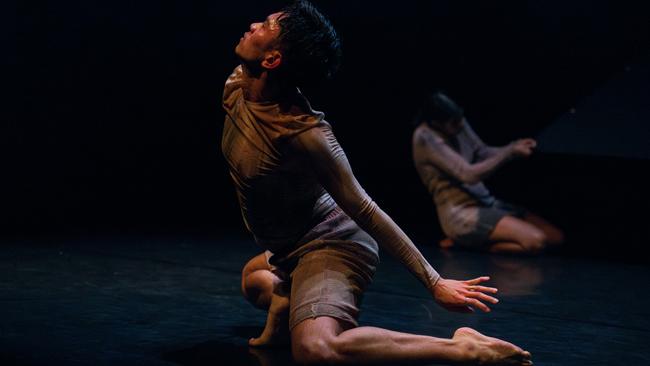
Time Machine
Her Majesty’s Theatre
March 14 – 17
5 stars

When some of Elizabeth Streb’s performers crawled like spiders all over the London Eye as part of the 2012 Olympics, a whole new audience became aware of this trailblazing New Yorker’s unique style of movement.
Supremely athletic, and often wildly exciting, yet capable of balletic poise, her company Streb Extreme Action comes to Australia for the first time as part of the 2024 Adelaide Festival.
Time Machine is the all-embracing title of a retrospective dating as far back as the 1970s, when Streb’s challenging solo work first emerged.
Her aim is simple, to defy gravity and fly. The first of the pieces, using a gigantic semicircular platform, is a brilliant demonstration, as the performers leap on and off, tilting the apparatus oh-so-close to the feared point of no return. Will it topple over? It’s not quite heart-stopping, but it certainly does focus the mind!
In one of the solo works, “Little Ease”, the performer stalks around an elevated rectangular box, seemingly disinterested, only to leap into the space and cling as if glued to the wall. The physical strength can scarcely be imagined. Then dropping dead flat, with a thud. The audience gasps, some shout. It’s enervating in the extreme.
The final piece is an exhilarating trampoline sequence, in which the performers achieve the acrobatic version of those magic leaps in ballet when time stands still. How can they stay aloft for so long?
Some flap like birds, others soar, and there are even some flying fish. Yet every landing, like every other landing, is booming, flat and hard.
Time Machine is exhausting to watch, but what a worthwhile effort it is.
– Peter Burdon
There Will Come Soft Rain
Adelaide Town Hall
March 13
5 stars

The Adelaide Chamber Singers took their rightful place as a Festival class ensemble in a program mixing the familiar and the new, established techniques and unusual sonorities, inspired by images of flight.
Familiar works from their repertoire included Leek’s Kondallila and the Whitacre ‘Leonardo dreams of his flying machine’ but some fine new pieces made this a very significant event in Adelaide’s choral history. Christie Anderson and choir came up with a committed and engaging program.
The title piece ‘There will come soft rain’ is a reworking by Carl Crossin, founder director of ACS of a work originally composed for five chamber choirs and premiered in St Peter’s Cathedral last year.
This new piece is so closely shaped to the individual voices of the group the performance was seamless. Anne Cawrse’s ‘White Petals’ had the translucent glow of a Japanese enamel, and was followed by an ecstatic ‘O Salutaris Hostia’ of Esenvalds with Brooke Window and Alexandra Bollard as radiant soloists.
‘Where Sails Once Flew’ and its companion piece ‘Desert Sea’ of Luke Byrne, drawing on images of lakes, rivers and shipwrecks was superbly delivered, a complex and rewarding experience.
Ariel’s words of transformation from Shakespeare’s ‘The Tempest’ rose up through the sounds of singing, a metaphor for the magic of the music. It was enriched with Ryan Grunwald’s percussion and Thomas Marlin’s expressive cello improvisation.
Very few choral works cannot be improved by the addition of a cello.
– Ewart Shaw
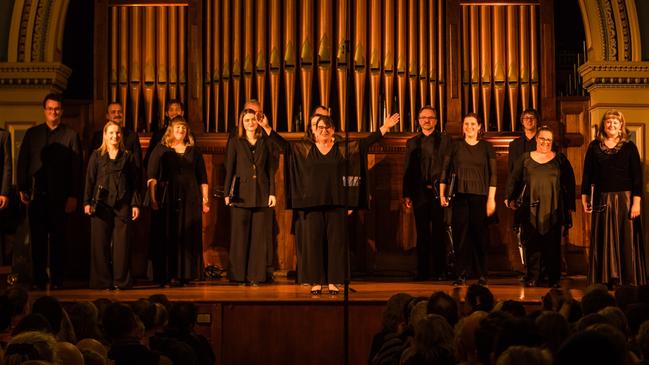
2024 Biennial of Australian Art
Art Gallery of South Australia
March 1 – June 2
5 stars
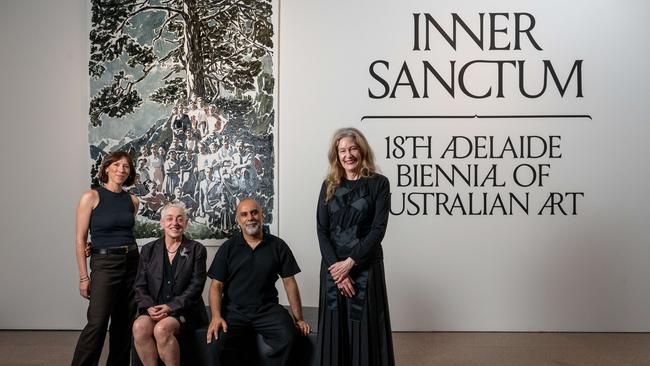
This might be the most ambitious of all the Adelaide Biennials in their 34-year history. By encompassing events, performance, poetry and refocusing them towards the visual arts it breaks the dimensions of what is to be experienced at the Art Gallery.
Trying to find thematic interweaves from 24 artists is a bit like herding cats but there is some credibility to curator Jose da Silva’s idea of Inner Sanctum, his title for the Biennial.
It is captured in Clara Adolphs’ series of large paintings full of nostalgia, memories of Australians at leisure in the 1940s and 1950s. Adolphs has worked from discarded family snaps from the era and turned them into instantly attractive scenes dappled in a subdued palette.
More directly, Khaled Sabsabi has built an inner sanctum sanctorum, filling an entire room with esoteric calculations on large canvases in a search for revelations in an obscure Sufi tradition.
But here is an exhibition that includes performances of Kate Llewellyn’s poetry set to music by Anne Cawrse and sung by the Adelaide Chamber Singers, or the ringing of Lawrence English’s 750kg bell at the gallery entrance, specially cast in search of a timbre that suits an Australian aesthetic.
And where does this Inner Sanctum lie for the audience?
In a defining opening section of the Biennial, The Inland Sea, the meeting of Australia’s indigenous and colonist’s myths and traditions can be found in Evelyn Araluen’s poem of the same name, and caught as overwhelming drama by Umoona senior cultural man George Cooley’s huge The Breakaways paintings in the European landscape tradition.
Jose da Silva has found many inner sanctum experiences for the Art Gallery, free of charge, worthy of many visits, and able to deliver precious moments to all.
Footnote: Due to breakages to one of Jasmine Togo-Brisby’s sculptures, one room of the exhibition has been closed pending replacement parts from interstate. It is expected to reopen on the March 16-17 weekend.
– Tim Lloyd
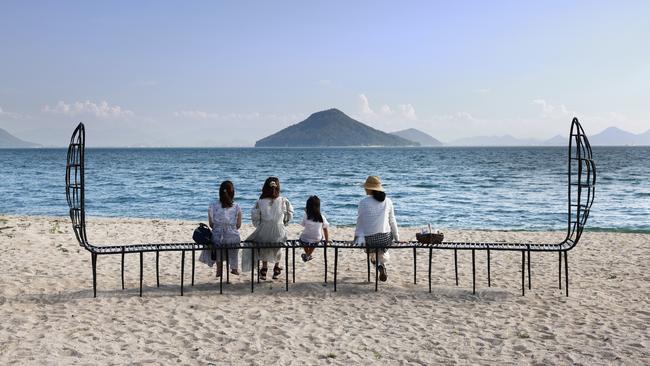
Helios
Migration Museum
Until March 17
4 stars
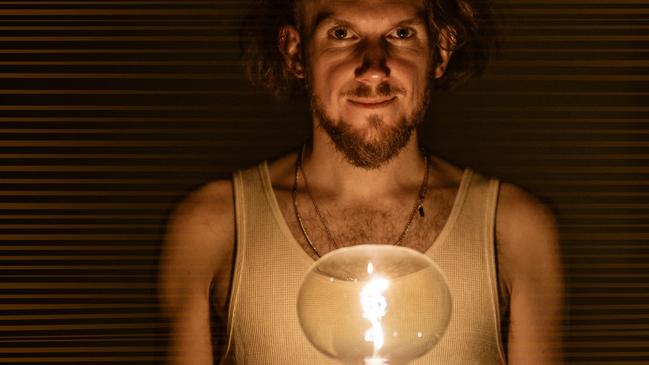
Alex Wright is a rough gem of a storyteller – Ancient Greeks would have called him a rhapsode – whose improbable task is to fuse our natural and mythological worlds with a tale about a latter-day Yorkshire boy living on a promise from his dad.
Young Phaeton’s Yorkshire village life is peopled with schoolmates like Michael, absentee father Helios, mum Rhode, and a fascination with the way the sun, that gigantic fusion reactor 93 million miles from Earth, floods into his room every morning.
His adventures parallel those of his namesake, but Wright is able to infuse the tale with layers of texture that bring Phaeton from myth to life.
He uses dialogue prompted with audience members, underlying music by his partner Phil Grainger, and a planetary set of lights to fill out the story.
Modern-day Phaeton is headed for a glorious finale in his golden Ford Mercury, and Wright reminds us of the spectacular chaotic aerial chariot-of-fire crash depicted by Peter Paul Rubens in 1605 of this same, mythical moment.
But this telling of Phaeton myth has its own moving revelations about Helios and our reason for being.
– Tim Lloyd

Angélique Kidjo
Festival Theatre
March 12
5 stars
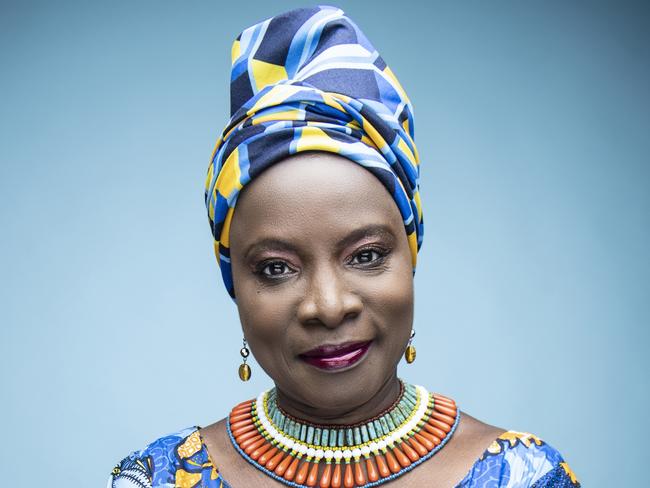
Angélique Kidjo is one of those rare artists who can effortlessly command the stage because of the person they are, not because of fancy production or any of the trappings of pop stardom.
She has a kind of dignity about her presence which is reassuring. This is not about ego, it’s about something more important than just one person. At the same, she is incredibly active onstage and her dancing is something marvellous to behold. It is like the distilled essence of being African in movement, which her music is in sound.
She has a terrific band touring with her, musical chameleons who can change the way they play to reflect the many influences that have flowed into her music, from Afrobeat to jazz, salsa and much more. The sentiments she expresses in her music are deep and inspiring.
In case anyone missed the point – which seems unlikely – she gave a short speech about the need for all of us to work together to end needless suffering, war, prejudice, antisemitism and other things that blight the world – despite which she remains an optimist. Her songs speak powerfully to that optimism.
Her support act was the Western Australian Maatakitj and his group, singing evocative songs of indigenous Noongar Australians. They joined her at the end, along with Young Adelaide Voices in a joyous finale to one of the most compelling live acts to grace the Festival Theatre stage.
– Stephen Whittington

Pt Tejendra Narayan Majumdar & Dr Ambi Subramaniam
Elder Hall
March 12
5 stars
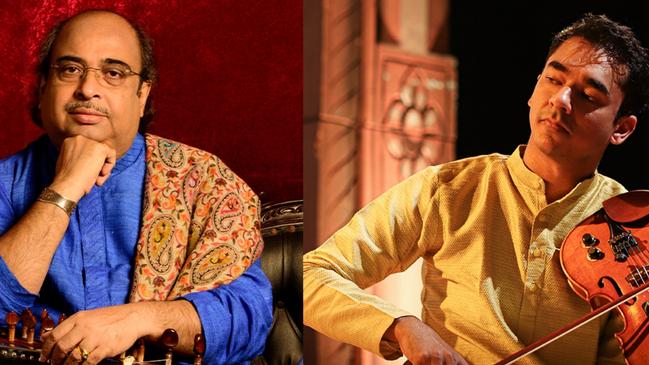
Carnatic music – the musical tradition of South India – is quite distinct from the Hindustani or northern tradition.
It was unusual to hear two great performers of these disparate traditions – Dr Ambi Subramaniam and Pandit Tejendra Narayan Majumdar – playing together. Not only that, they each had a drummer with them – Tanmoy Bose on (northern) tabla, and V V Ramana Murthy on the (southern) mridangam. The two traditions merged almost seamlessly in the hands of these masters of their art. In the hands of Pandit Majumdar the sarod is an instrument of limitless subtlety and precise emotional expression. Sometimes his notes seem to dissolve into nothing, or spin off into another dimension. Matching him for subtlety are the exquisite sounds of the violin of Dr Ambi Subramaniam, producing extraordinary melodic arcs. The two percussionists effortlessly performed complex mathematics in real time, duelling with one another to produce the most fiendish rhythmic inventions. The endless creativity of these four musicians displayed the immense wealth of these two great Indian traditions, brought together in one utterly engrossing performance.
If you are old enough to remember the concerts in years past in Elder Hall by L. Subramaniam, father of Ambi Subramaniam, you will most likely have them among your most precious musical memories. Now there is a new memory to add in this truly remarkable performance.
– Stephen Whittington
Ensemble Offspring: Night Songs
Space Theatre
March 12 – March 13
4 stars
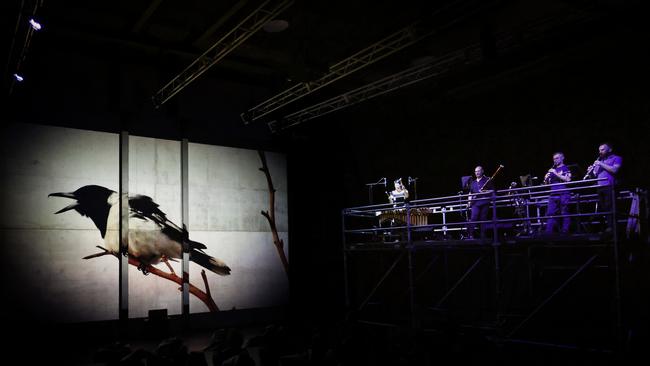
This collaboration between musician, ornithologist and author Hollis Taylor, along with violinist and composer Jon Rose, has resulted in a thoroughly whimsical, deliciously natural and always musical event – featuring one of Australia’s greatest songbirds, the Pied Butcherbird.
Hailing from Centralia, this endearing creature has the widest variety of pitch vocabulary and judging from the colourful film recordings, sings in tune. And sings at night. Hollis Taylor’s audio visuals, seen on a big screen, must have taken forever to assemble, and the result is arresting.
As the program note suggests, the bird’s song is ancient, while John Rose’s score for eight musicians playing in real time is provocatively contemporary. Moreover, Rose unashamedly mirrors the birdcalls, sometimes accompanying, at others veering off into elaborate improvisational textures that reflect and contemplate.
The seance-like experience lasts around an hour and encompasses settings from Cape Range National Park to Ross River and beyond.
Ensemble Offspring’s eight players, led by new music luminary percussionist Claire Edwardes, are positioned either side of the screen giving a stereophonic effect even before they begin interpreting the extended techniques Rose demands. The experience is totally immersive yet gently rather than boldly persuasive, thanks to the sometimes-older film footage.
In the final number Rose writes tonally for the first time, producing a sepia effect alongside the Pied Butcherbird’s exquisitely graceful and so in tune sonics. A beautiful end to this unassuming and very natural show.
– Rodney Smith
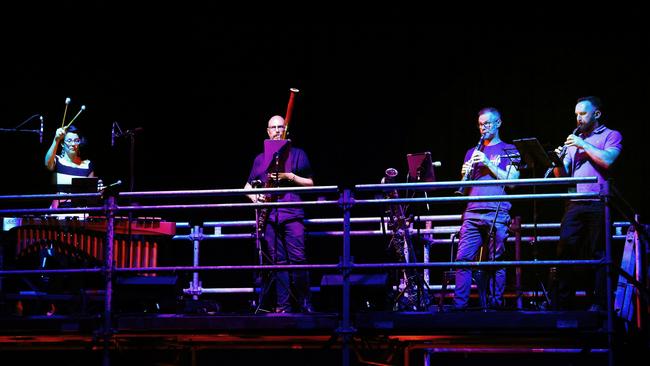
Qui a tue mon pere (Who killed my father)
Dunstan Playhouse
March 8-10
4 stars
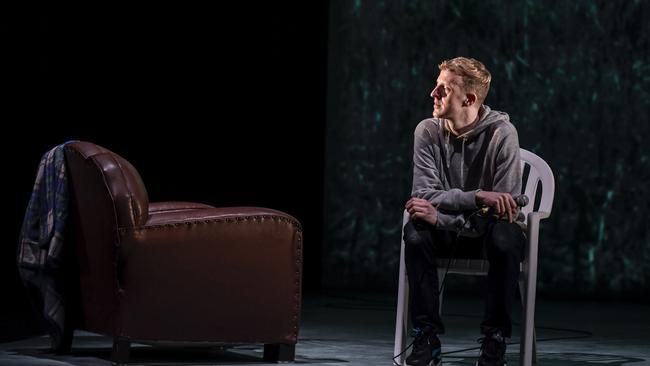
In a country famed for its elites, its ordered meritocracy and their disdain for France’s provincials, Edouard Louis is an ultimate disrupter.
He has made his way from a disadvantaged, bigoted family barely surviving on social welfare in France’s northern boondocks to be educated at its most prestigious tertiary institutions before becoming famous for his critiques of his nation’s social order.
At 32, he is a best-selling author, read in 20 languages, single-handedly moving the dial on social justice causes.
Now he has come to the Adelaide Festival, first to Writers Week and then to perform as the central character in an adaptation of his autobiographical novel, Who Killed My Father, that continues his remaking of French self-regard.
He was persuaded to take this unusual role of himself by one of Europe’s leading directors, Thomas Ostermeier of the Schaubuhne Berlin.
Louis delivers his story mostly in French with subtitles on a screen that often projects slow progress through heavy mists on French highways. His father is represented by an old stuffed armchair downstage.
It’s not a pretty picture, especially once his redneck, alcoholic and abusive father discovers his son is homosexual.
Louis rises above it all to consider his family’s treatment by an indifferent governing class, especially since his father was hopelessly mangled in an industrial accident.
Is he witnessing a killing?
Louis strings up mugshots of his likely suspects, French presidents from Nicolas Sarkozy to Emmanuel Macron, and their progression of humiliations of his family’s kind.
Authenticity is everything in theatre and politics, and here we have it in spades, Louis forging a powerful bond with the audience.
– Tim Lloyd
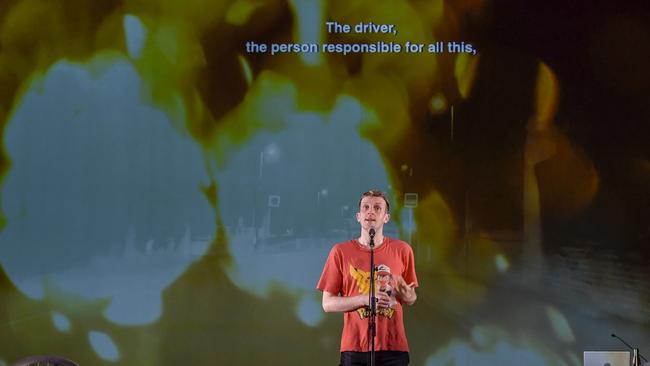
Nothing: Chamber Landscapes
Ukaria Cultural Centre
Sunday, March 10
4 stars

Making something out of Nothing is just the sort of challenge Chamber Landscapes curator Richard Tognetti revels in, and unsurprisingly, he has magically conjured up a very great deal. In fact, Tognetti and his 18 co-artists produced a riot of colour and mind-bending exploration.
Day three of this event comprised three concerts each with a different take on the idea of Nothing.
Perhaps the first two concerts produced the most cohesive listening experience, each containing substantial works that made a strong statement. The opening concert’s title, “Something I Can Never Have”, comes from industrial rock band Nine Inch Nails’ 1989 debut album.
Tognetti’s arrangement for seven performers including the arrestingly dark rich tones of star violinist Satu Vanska as vocalist on this occasion, gave the program a highly charged core alongside music of Janácek, Schubert and Pärt.
Thanks for Nothing, the midafternoon concert, was immediately etched on listeners’ consciousness by a startlingly iridescent performance from mesmerising violist Hanna Lee and pianist powerhouse Konstantin Shamray of Rebecca Clarke’s now well-established “Viola Sonata”.
When composed in 1919 Clarke had to overcome doubts whether a women could really have written it. Alongside this sizzling performance Jakub Jankowski’s Nevermore, in its world premiere, proved an enticing spellbinder, spanning texts from Ecclesiastes to Baudelaire.
The evening concert, Disappearing into Nothing, had moments of seeming obscurity with Tognetti moving straight from Samuel Adams’ world premiere performance of “Berceuse” to “Morton Feldman’s Rothko Chapel V” without a break, as if they were one work.
Listeners had just experienced Cage’s silent piece 4’33 and may not have regained their bearings until Janacek’s clearly identifiable “The Diary of One Who Disappeared” got them back on track in a potent performance from tenor Louis Hurley and pianist Konstantin Shamray.
– Rodney Smith

The Threepenny Opera
Her Majesty’s Theatre
March 6 – March 10
5 stars
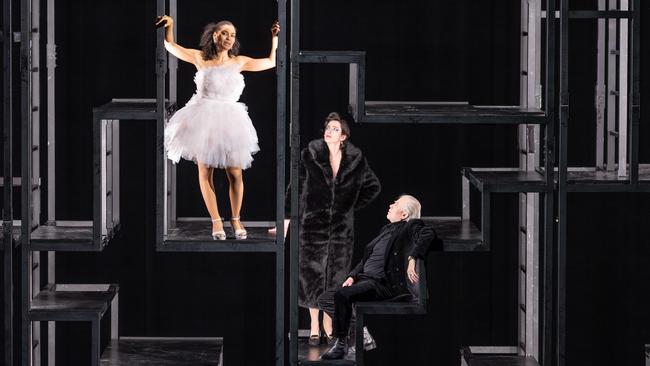
A white painted face peeps through the glittering curtain and sings “Mack the Knife”. A pair of feet parts the strands and Peachum arrives. The story begins.
Direct from Berlin, home of Berthold Brecht and Kurt Weill, Adelaide receives a gift from the fabled Berliner Ensemble. Barry Kosky replaces the gin soaked stench of 1728 London and the caustic wit of 1929 Berlin with corporate 2024 style, cynical and clinical.
Behind the sparkly curtain is the Escher inspired set of black and chrome. The hydraulics have broken down and the singers climb and clutch instead of ascending and descending. It takes a while for them to settle but once their feet are on the ground, they tell the tale of corruption and seduction in German and at times in English. The story is so contemporary, there’s a threat to disrupt a Coronation.
Weill’s score, some of the most famous of all German cabaret songs, covered by thousands, rises from the pit. Adam Benzwi and his crew are outstanding and authentic.
Gabriel Schneider is a seductive, youthful Macheath. He’s personable and promiscuous, easily and ambitiously seducing Polly Peachum, the stylish Cynthia Michas and Lucy Brown, the manically energetic Laura Balzer. Tilo Nest and Costanze Becker are the Peachums, running London’s beggars as a business, in cahoots with Tiger Brown of Scotland Yard, the cross gender cast Kathrin Wehlisch.
Julia Berger is the prostitute jenny, coolly observant and a fine singer.
The long first act plays out growing in colour and tension. Then the knife flashes, a man dies in a pool of blood and the entire company launch into a powerful chorale. The second act belongs to Schneider whose long soliloquy is mesmerising. Then he’s hanged.
The Queen’s pardon arrives and he’s revived, redressed and elevated to the peerage. Finally, he stands, neatly suited as a young executive. It’s the blood on his face that gives the game away.
– Ewart Shaw

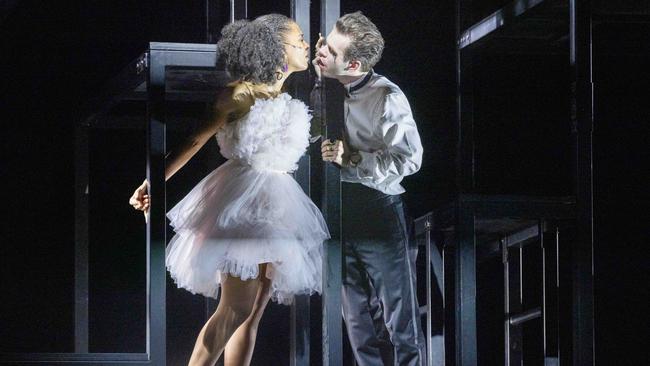
Aspects of Nothing – Chamber Landscapes
UKARIA
March 8
3 stars
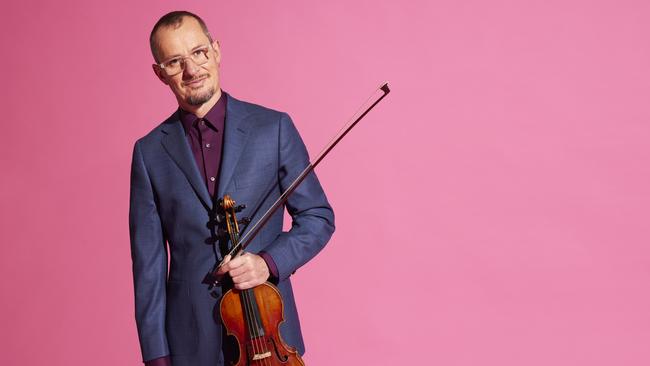
Another year, another chamber music concert without any music by women on International Women’s Day.
Such an omission might be understandable had the music in this concert fit better with its theme of Aspects of Nothing. But it was an artistic hodgepodge, with only the loosest of connections between the works on the program, and with the overarching concept.
The opening piece was Massenet’s ubiquitous “Méditation”; its meditative nature was perhaps the most clearly linked with nothingness, even if Richard Tognetti’s rushed and abrupt phrasing belied this quality.
Tognetti, the Chamber Landscapes program curator, drew a tenuous connection between nothingness and the nonsense of Dadaism. In this concert, it came in the form of selections from Satie’s “Cancelled” interspersed with readings of the composer’s nonsense texts. Actor Katherine Tonkin and pianist Konstantin Shamray captured the spirit of these with flair and excellent timing.
Going from Satie to Tognetti’s “Metho Drinker” (a setting of Judith Wright’s poem of the same name) involved some serious tonal whiplash. The depth and darkness of both the poem and Tognetti’s setting might have felt more profound if included at a later point in the program.
The concert’s second half consisted entirely of Beethoven string quartets. Although a very conservative repertoire choice, the performers used extremes of dynamics and timbre in their interpretation, and the relentless intensity of their playing in the “Grosse Fugue” was exciting if antithetical to nothingness.
Four stars for the musicality and technical control from the performers, but two stars for the patchwork programming.
– Melanie Walters
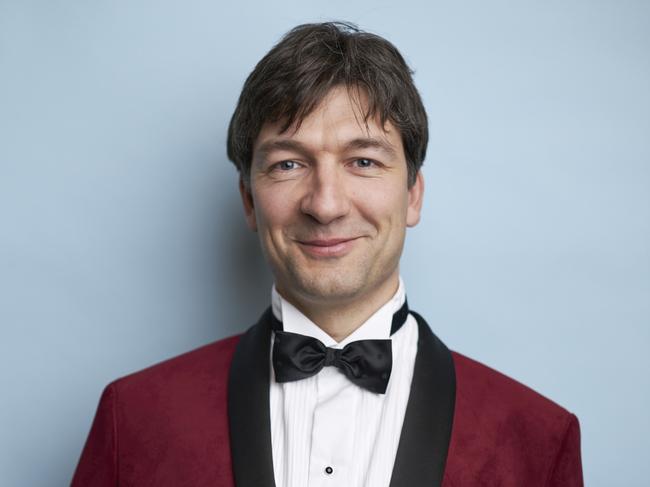
I Hide in Bathrooms
Waterside Workers Hall
March 5 – March 16
4 stars
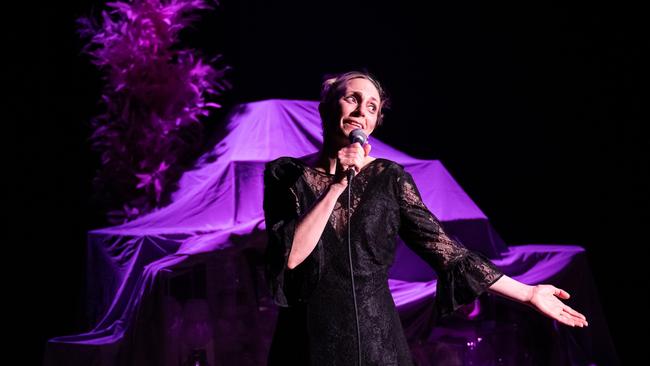
In this production actor Astrid Pill dies a thousand deaths. Death by coronary, death by gun, how about death by labradoodle?
She falls, slumps, trips, or simply expires while lying down.
Death by stretching, death by bus, death by Instagram.
Astrid Pill’s thesis on dealing with death is a gentle, subtle entertainment driven by her great skill as a physical comedy performer in particular.
She is in widow’s weeds, since she has lost her husband, or wife, and is a widow, or a widower. Her lost one has died from myriad causes. Or she is the dying one, cancer this time.
She captures moments that many in the audience know. She catches sight of her dead loved one, and then realises, not.
She feels half of herself is missing. She wonders if she is pretending to mourn. She smudges her mascara with wine. She is missing comfort, sex, companionship. Tissues are supplied on every seat, with a sprig of thyme.
These many, many riffs on death are dressed in a production full of invention. The stage has a simple set of cloth-covered shapes, revealed as the relics of a life spent together. The auditorium seats rake down and then sink into the stage, leaving just the top of backrests, as though the audience is on a conveyor to oblivion.
At the rear, projections of Pill’s face, or her many faces, comment on her and her ideas.
Death is always a powerful theme in theatre and the arts (and life), and with only a few lapses this many-faceted play holds our attention, not in a morbid way, but generous in spirit.
– Tim Lloyd

Anthony Romaniuk: Perpetuum
Elder Hall
March 7
5 stars
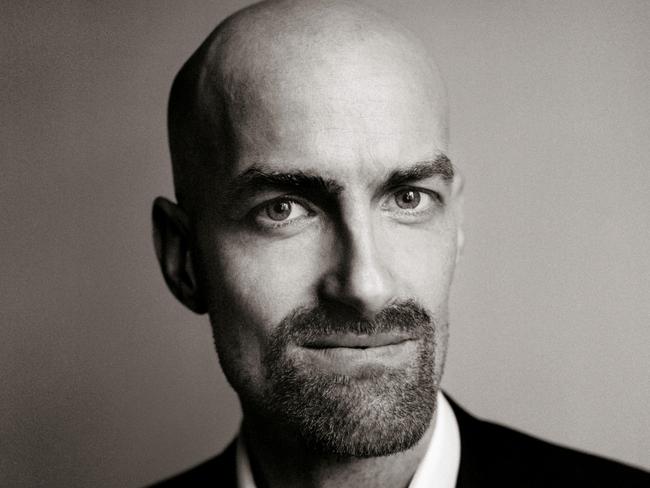
According to physics, a perpetual motion machine is impossible.
Anthony Romaniuk is as close as possible to being a human perpetual motion machine. Playing three different keyboards – piano, electronic keyboard and harpsichord – he hardly paused for more than an hour in this brilliantly conceived program appropriately called Perpetuum. Every piece – there were more than twenty – maintained movement at a constant speed from beginning to end, ranging from moderate to extremely fast.
Careful attention was paid to the connection between successive pieces so that the transition was never jarring. Romaniuk swivelled from one keyboard to another, on one occasion playing two simultaneously in order to effect a seamless connection.
Romaniuk’s versatility allows him program music as different as 16th century organ music, Bach, Satie and Ligeti – and much more. His own improvisations revealed his jazz background, which occasionally also filtered subtly into the articulation of the classics.
It is hard to pick highlights out of Romaniuk’s totally engrossing performance, but Ligeti’s “Etude Fanfare”, Bach’s “Toccata” in E minor and his own arrangement of “Toccata Arpeggiata” by Kapsberger were memorable.
Anthony Romaniuk is an admirable representative of the contemporary generation of musicians who are comfortable across many kinds of music from the classics to contemporary music and improvisation and are taking the old style recital in new and fascinating directions. We need more of them.
– Stephen Whittington
Long Lost Loves (and Grey Suede Gloves)
Adelaide Town Hall
March 7
2 stars

William Bolcom’s cabaret songs are an unlikely mixture of styles from American popular music and modern idioms.
Some are playful, some are serious, some are sentimental. Some – the best of them, like Amor — could have been written by Charles Ives. In this performance by mezzosoprano Anna Dowsley with pianist Michael Curtain, some twenty of these songs were strung together within the narrative frame of the funeral of George, recently deceased from apparently violent causes.
The concept was good, and the performers very talented, and it might have worked well.
Two things prevented it from fulfilling its potential. The Town Hall is too large, unless perhaps you were seated in the front ten rows, where you might feel more engaged with the action on stage.
Not long ago Dawn Upshaw sang a few of these songs at UKARIA and they were captivating in that intimate setting. The other problem was that, particularly when Anna Dowsley moved into full operatic voice, the words were largely unintelligible.
There were no lyrics in the program because the hall was dark for the performance, and no surtitles. I’m fairly certain that my hearing is good for my age, in which case I must assume that many people in the audience were left guessing what it was all about.
Whether a production of this kind did the music any favours is debatable. Sitting through the performance, thinking about how it might have been, was frustrating.
– Stephen Whittington
Marina Abramovic Institute: Takeover
Space Theatre and surrounds
March 1 – March 4
4 stars

Artistic director Ruth Mackenzie’s first Adelaide Festival has broken down conventions of theatre with Blue, where the setting is dominant, with Goodbye Lindita, where the actors are mute, and with Guuranda, driven by dance, puppetry, and projections.
With Takeover she adds performance art, where visual artists are not just the makers of the artwork but are live, performative ingredients. And even within that form she has chosen long-duration performance, where the artists’ endurance is stretched to the limit.
Marina Abramovic is the internationally renowned self-described grandmother of this art form, and her Institute has assembled some remarkable long-duration artists from around the world.
The main event is Australia’s best-known performance artist, Mike Parr, here repeatedly painting great splotches of red on black on an enclosed box structure in the Space.
He is making splotches because he stands unsteadily, high on a ladder, and he paints with his eyes closed.
It’s an HR nightmare and he and his support crew are all daubed in the work.
Similarly, Li Binyuan, from China, perched himself last Saturday, March 2, atop a large four-metre high brick pillar in Elder Park before proceeding to demolish from the top down in a painfully slow process using a small pickaxe.
Meanwhile, in the playhouse rehearsal room Indonesia’s Melati Suryodarmo sewed black smocks at a sewing machine before making tally marks in sets of five on a vast chalkboard, saying “I am sorry” with every stroke.
These and a half dozen other peculiar scenes in and around the Festival Centre greet the viewer and challenge them to make something of them.
A clue is given by Marina Abramovic, who in a video demonstrates the Abramovic Method – meditational exercises designed to slow breath and heartbeat – to equip audience members for what lies within.
She helpfully justifies long-duration art, saying: “The present is the only reality we can ever have”.
– Tim Lloyd

The Rest is Politics Live
Adelaide Town Hall
March 3
4 stars
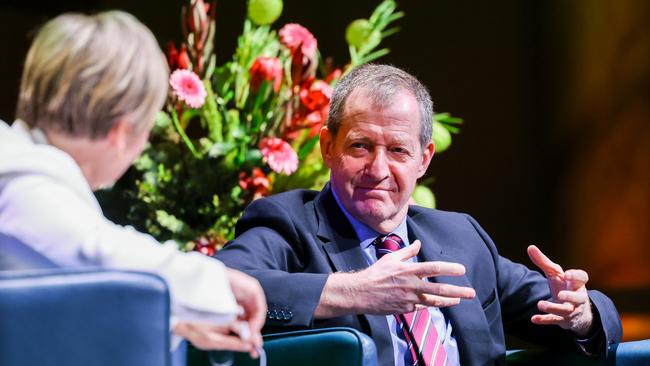
In a global political world that is ever more polarised, and characterised by people screaming at each other from either end of the ideological spectrum, what can be read into the fact that one of the most successful podcasts in the world is two blokes being reasonable with each other?
Certainly, Alastair Campbell and Rory Stewart have differing political views, which is part of the attraction of their twice-weekly podcast, The Rest is Politics.
Campbell, most famously Tony Blair’s chief media enforcer, is of the tribal Labour variety, while Stewart was a Tory Cabinet minister and ran for the party’s leadership against a certain Boris Johnson.
But both are also essentially centrists, what unites them is stronger than what divides them – that being a passion for functioning democracy and serious politicians delivering serious policy.
In front of a sold out Town Hall as part of Adelaide Writers’ Week, Campbell said Australia was the podcast’s second biggest market after the UK, the duo ran through all the big issues, Gaza, Brexit, the decline of political culture.
Campbell lamented the rise of populism through characters such as Donald Trump and Boris Johnson, “populism is the exploitation of other people’s misery,’’ was his view.
Stewart beamed in from his home in England made some withering comments of ex-PM Liz Truss and her new book – “Selling a book called Ten Years to Save the West when she managed to blow up the UK economy in just over 40 days’’.
The crowd lapped it up.
That those talking about politics are more respected than those actually in politics could be one of the problems.
– Michael McGuire
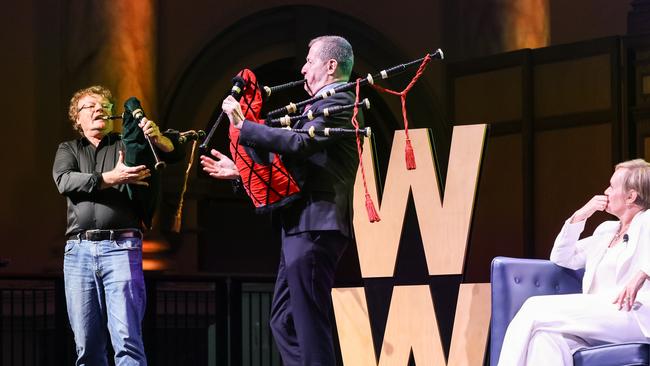
Grand Theft Theatre
Latvian Hall
March 3 – March 11
4 stars
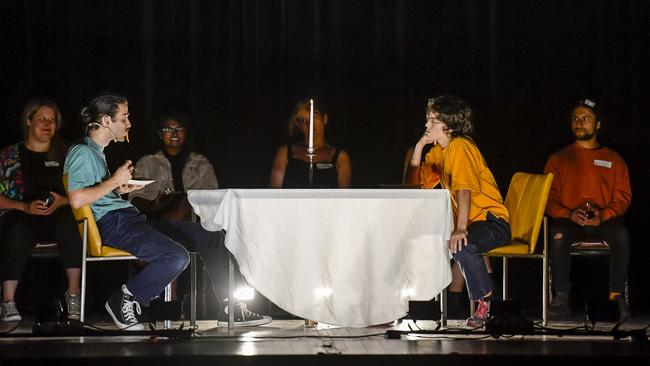
Here we have a thieving bunch of drama people who entertain themselves – and the audience – by reliving the best shows they have seen.
But don’t expect any re-runs.
Turn by turn each of the six performers sets out to relive shows they saw, perhaps 20 years ago, perhaps this year.
Of course it is a shambles.
How can an actor re-make a theatrical experience?
But in failing to tell us one thing they tell another.
And what do they remember? Unreliable stories of intriguing plots, Irish dance shows, naked performers doing strange things with roses, a violent encounter, 12 pints in an Adelaide Fringe show.
There is blood, in sprays of tomato sauce; and vomiting, in spews of Russian salad.
Grand Theft Theatre is a deconstruction of theatre to see if it can make another form of theatre.
There’s even a moment Adelaide Festival goers will savour where they perform a freewheeling mash-up of the theatre they’ve seen in this year’s Adelaide Festival, starting with a parade of chocolate Easter bunnies for The Nightingale and Other Fables’ farmyard scenes.
It seems to be a chaotic free-for-all by drama students but the performances are tightly cued, and tightly choreographed, and sometimes hysterically funny.
The audience is rearranged in the Latvian Hall for each act, and that just about does it for a plot.
But there is no fourth wall, and by the time we are sitting on the stage looking out into the auditorium a kind of intimacy has developed with this bunch and their fractured snippets of the shows they have thieved.
So, yes, it is theatre, good theatre, but not the theatre we know.
It nicely expands on the themes of anything-but-conventional drama performances that Adelaide Festival director Ruth Mackenzie has made a feature in 2024.
– Tim Lloyd
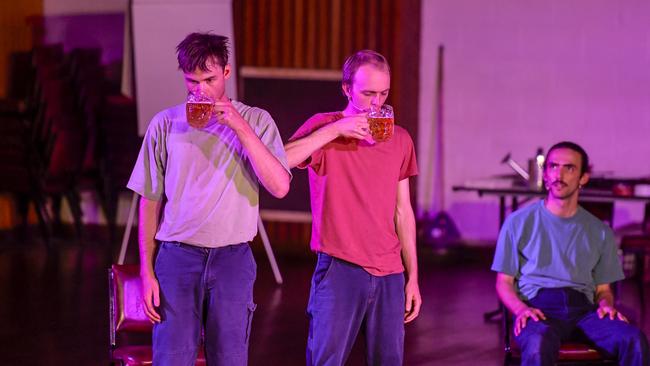
Daylight Express – Meredith Arwady
Elder Hall
March 4
5 stars
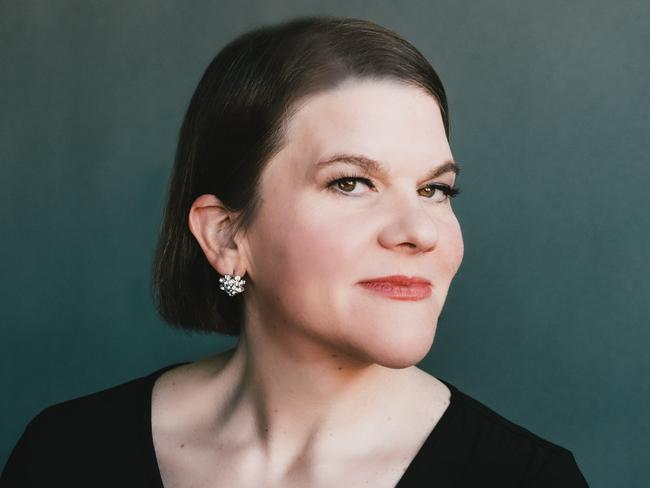
The voice catches you first, the stage presence then draws you in, and as a result there was rapt attention from everyone during American contralto Meredith Arwady’s solo recital.
It was also a golden opportunity for listeners to hear her in repertoire beyond her major role in Stravinsky’s The Nightingale, a top Festival drawcard.
Arwady positively relished the barbed wit and dark humour of brackets from American musicals, but there was serious business too in the program’s considerable content of American religious songs, projected with all the fervour you could wish for.
Arwady’s voice is a truly soloistic contralto, with real power and punch in the lower as well as higher registers that allows her to mould and encapsulate a phrase and a sentence with tremendous clarity.
And yet there is a well of tenderness and compassion on which she can draw for the most colourful effects.
Her musicianship is superb and clearly she feels completely at home in numbers ranging from Gershwin’s “Summertime” (Porgy and Bess) to the Sherman Brothers’ “Feed the Birds” (Mary Poppins).
She certainly revelled in the sardonic comedy of Tom Lehrer’s “Poisoning Pigeons in the Park” and Richard Rodgers’ “Stepsisters’ Lament” (Cinderella) and as if this wasn’t enough there was pathos aplenty in Britten’s “O Waly, Waly” and John Jacob Niles’ “Go from My Window”.
Pianist Michael Ierace proved an impeccable musical partner.
From the tonal delicacies of Samuel Barber to the funky rhythms of Cole Porter he never missed a beat.
– Rodney Smith
Baleen Moondjan
Glenelg Beach
February 28 – March 2
5 stars
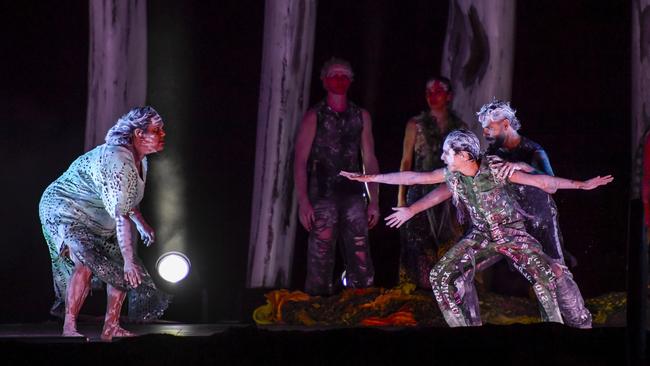
A vast colonnade of white bones makes for an epic setting for Stephen Page’s Baleen Moondjan, the curtain-raiser for the 2024 Adelaide Festival.
The sight is sad in some ways. A glorious giant of the sea has died, its skeleton a stark if monumental reminder of what once was. Yet it is joyous, for we know that it comes after a life lived in the cool embrace of the world’s oceans.
This event – it’s much more than a show, really it’s more an experience – is vast in scale, yet grounded and intensely personal, based as it is on a story from Page’s grandmother from her own people on Minjerribah – Stradbroke Island – off the coast of Meanjin.
Many of Page’s collaborators from his many years with Bangarra Dance Theatre feature prominently in the work. Performer Elaine Crombie as Moondjan elder Gindara is a grounding presence in any cast, and she weaves in and out of the physical and spiritual realms in harmony with the story. There are also plenty of familiar names among the dancers, whose performances are uniformly excellent. Musicians Jorjabelle Munday and Taj Pilgrim play an impressive score from Steve Francis.
The costumes by Jennifer Irwin work well in such a large space, while the set from Jacob Nash is astounding even by his high standards.
Baleen Moondjan is truly immersive. Sand between your toes, the lapping waves, and if you get there early enough (strongly recommended, bring a picnic) the setting sun reflecting on the water, then a performance that is epic in scale yet tightly focused on the resilience of the land and its people, and the threats to their very existence. It’s a cracker.
– Peter Burdon

The Nightingale and Other Fables
Adelaide Festival Theatre
March 1 – March 6
5 stars
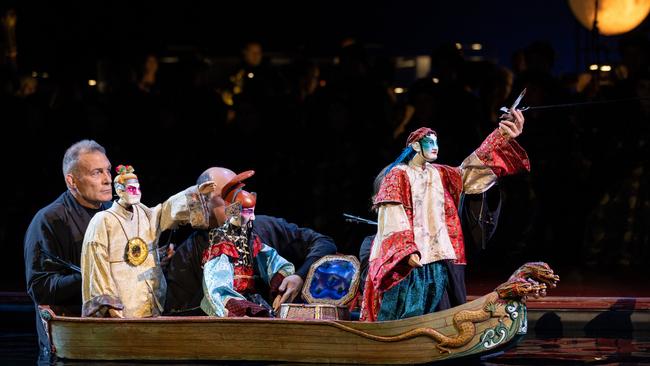
Stravinsky’s enchanting nightingale landed lightly in Adelaide and Festival goers became children again.
Robert Lepage’s justifiably universally loved production draws on many Asian puppetry traditions to show us the amazing craft behind the art. We see the operators and singers waist deep in water, we see the orchestra.
The dolls are exquisitely fabricated and manipulated. The costumes, heavily embroidered, glow with silken lustre. The whole experience is mesmerising. And yet, the nightingale itself is a dowdy bunch of feathers, floating with eye catching presence above all the extravagant business below.
The story is simple. The emperor of China loves the singing of the real nightingale, but she is replaced by a mechanical bird from the Japanese emperor.
The repetitive tune is not enough to save the emperor from death but the loyal true bird reappears, charms Death and restores life. The metaphor for the power of live music over machine made melodies could not be clearer.
Yuliia Zasimova, the incarnated Nightingale, moves through the artificial world with grace and a voice of eloquent beauty. There is power in the voices of Owen McCausland as the Fisherman and Taras Berezhansky as the Emperor.
The Canadian and Ukrainian singers are joined by fine Australians alive to the comic and dramatic potential of the score. With the orchestra behind them the voices soar.
Alejo Perez directs the full Adelaide Symphony Orchestra and the many smaller ensembles it provides, with great skill and a deep understanding of the various currents that flow through the music.
The State Opera Chorus, under the direction of Antony Hunt, maintain their reputation as a serious fighting force. Have they ever looked so exotic?
The prelude to all this is a collection of Stravinsky’s shorter pieces, songs and stories including Renard the Fox. Linked by Dean Newcomb’s fluid clarinet playing, these were dispatched with great charm, fine singing and very funny shadow play by the hands of the company’s puppeteers. They also served as an introduction to Stravinsky’s musical vocabulary and the sound of sung Russian.
– Ewart Shaw
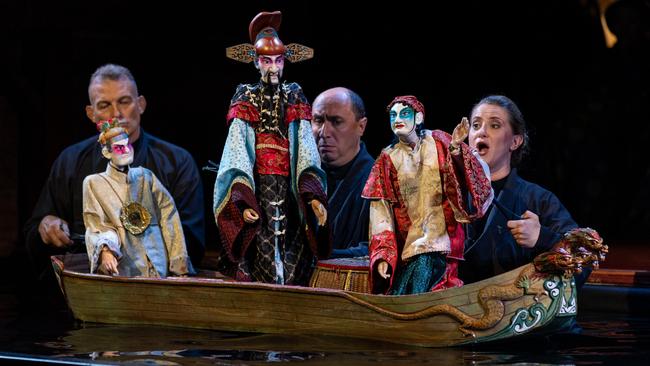
Goodbye, Lindita
Dunstan Playhouse
February 28 – March 3
5 stars

What is to be said after a death in the family? Grief is a lonely thing, but ritual is the comfort of ages.
In this amazing production from Greece, the words simply can’t be said and everything is expressed in the mute actions of those left behind.
Loss has visited this ordinary family home. They stare blankly at the TV, fold away clothes no longer needed, retire desolate to bed.
Director Mario Banushi has a style that borrows from magic, surrealism and surprise as the ritual surrounding a death unfolds. He uses the great clanging sounds of clearing the spirits, and the sudden wafts of incense smoke out into the audience to evoke our response.
The drama on stage is in the choked cries as family members bury themselves in the smell of the clothes. The body suddenly appears out of nowhere, lying naked as she is stroked and wept over. She is stood up, and stares blankly out into the audience. A great operatic aria sounds.
Her nakedness is a powerful image of the body without life, here made plain as hands wash and run all over her. She is being prepared, washed at a crypt, and suddenly, spectacularly transformed into an icon.
A black Madonna, common in Byzantine tradition, appears at the window, strums her many-stringed kora, and sings an incantation. She brings a mysticism as she is gradually absorbed into the performance and even into the set.
The procession of such scenes is completely absorbing, the religious references end with a magnificent pieta-like scene. It is a precious moment of theatre.
– Tim Lloyd
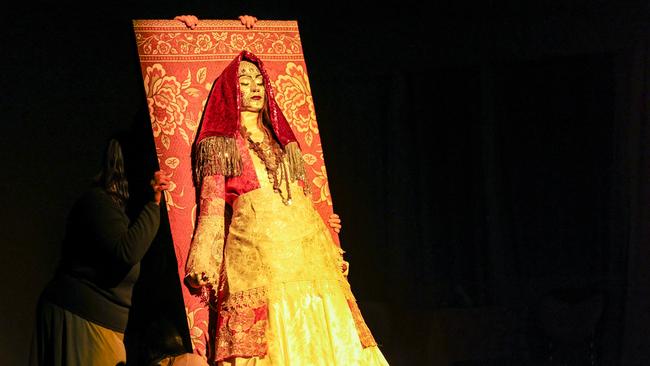
Blue
Scott Theatre
February 23 – March 16
4 stars
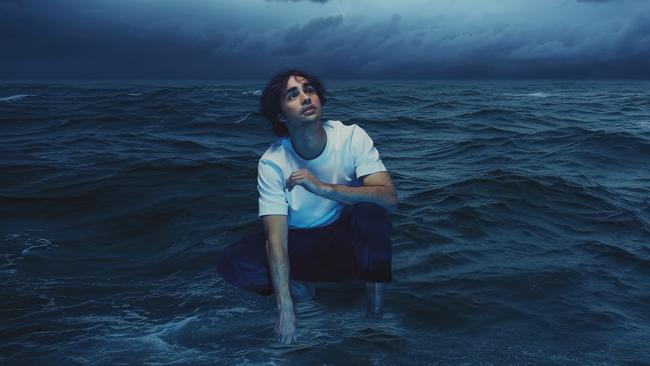
There is a winning stage device in Blue where the backdrop grows out of the stage as a vast, crinkled canvas that captures the colours and emotions of the performer, particularly in the blue of the sea, central to this play.
At times it projects gentle ebbs and flows lapping on a shore, but the waves can grow and at times are overwhelming, or the horizon bends, and vertigo comes.
Blue is a play not so much about the blue of depression as it is about the great waves that ebb and flow in our lives.
The procession of colours and effects, the deep shudder of sounds, and the splashes of actual water are there to broaden and deepen a monologue, written by Thomas Weatherall, delivered simply, humbly, by Mark, played here by Callan Purcell.
Jacob Nash, the designer, is at the creative heart of this Belvoir St Theatre production.
Mark is special, a surviving twin, with certain needs, found mostly in the loving routines of his mother, and adventures with his year older brother John. But when John is lost to him the drama plays out mostly on the stage around him as Mark calmly recites the physiology of drowning, like a mantra.
The sea becomes violent, fiery, and transforms adamant into a red stone wall that turns grey with the effects of Zoloft and Prozac after self-harm, and then clinical; brilliantly white.
These superlative effects project the emotions in unusual ways for stage plays and are a worthy and unusual experiment for theatregoers, and how they might individually respond.
Not so successful are the attempts to bring water on to the stage, to deliver a tactile dimension to Mark’s story as he launches himself into independence and adulthood.
Against the power of the visual imagery it demands much more than a dip in a shallow trough.
– Tim Lloyd
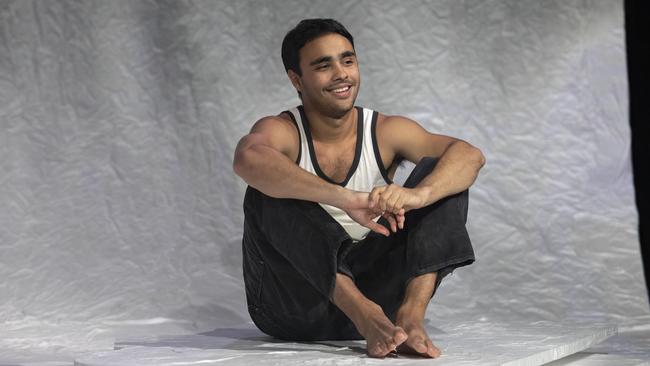
Guuranda
Her Majesty’s Theatre
February 29 – March 3
4 stars
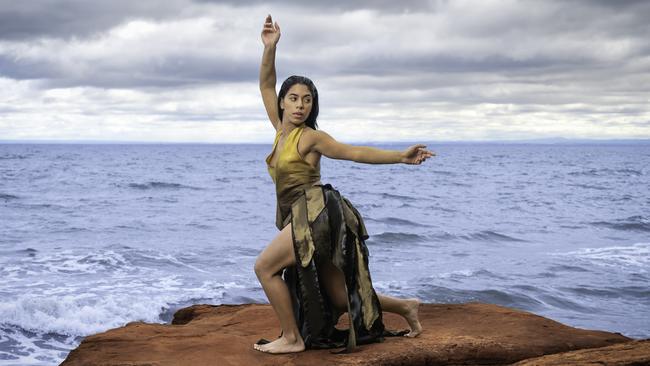
The Narungga country people of Yorke Peninsula have been able to bring their own creation myths to the Adelaide Festival in this groundbreaking production.
Narungga myths play out most successfully in dance sequences and in puppetry, while projections fill the stage with the Nurungga Nation’s peoples.
Not all the sections are successful, and an animation runs too long, diminishing the momentum of the whole.
But Jacob Boehme, the creative director, has made a distinctive, intriguing fusion.
Styles in dances and songs are both recognisably traditional yet contemporary, and immediately appealing.
The dance is centred from the earth but extends into contemporary and even balletic sequences and brings to mind Bangarra’s dance theatre at its best.
The music comes to the stage with a filmed choir of 25 Narungga, a clan gathering complete with babies, screened in brilliant relief behind events on stage.
On side screens projections two lead singers, songman Warren Milera and songwoman Sonya Rankine are fabulous as the tale tellers.
The stories unfolding on stage are about the transgressions of a Narungga warriors like the giant, Buthera, on neighbours’ territories.
It leads to glorious war scenes of wild dance and spear-throwing sequences choreographed by Boehme.
A second mythical tale is told with larger-than-life puppets designed to fit seamlessly with the dancers’ costumes, as the story of a second Narungga transgressor plays out between dingoes, emu and her chicks and an allegiance of other birds.
The last words are left to Narungga elders: their regrets at no longer being able to visit the sites central to their epic myths in what is a thriving but disengaged farming community.
– Tim Lloyd
More Coverage





